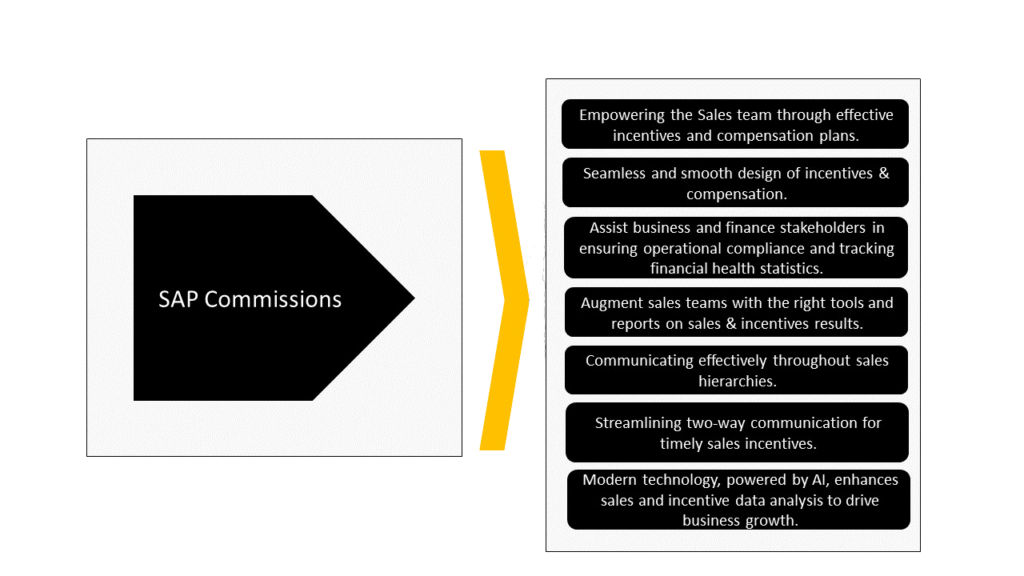SAP Commissions is a software solution that helps businesses design, implement, and manage incentive and commission programs for their sales force, partners, and employees. SAP Commissions enable businesses to align their sales strategies with their compensation plans, motivate their sales teams to achieve their goals and optimize their sales performance and revenue.

One of the key features of SAP Commissions is its flexible and robust plans and rules framework, which allows businesses to create and customize various types of incentive and commission plans according to their specific needs and requirements. The plans and rules framework consists of the following components:
- Plans: A plan defines the basic structure and parameters of an incentive or commission program, such as the target group, the calculation period, the payment frequency, the currency, and the rounding method. A plan can have one or more subplans, which are used to define different aspects or scenarios of the program, such as different products, regions, channels, or tiers. A plan can also have one or more plan versions, which are used to track changes or revisions to the program over time.
- Rules: A rule defines the logic and formula for calculating the incentive or commission amount for a given transaction or performance measure. A rule can have one or more conditions, which are used to specify the criteria or prerequisites for applying the rule. A rule can also have one or more actions, which are used to specify the calculation method, the rate, the factor, the cap, the minimum, or the maximum amount for the incentive or commission. A rule can also have one or more exceptions, which are used to override or modify the rule for certain cases or situations.
- Rate Tables: These are used to define commission rates or bonuses that are earned by individuals or teams based on specific criteria. These criteria can include sales revenue, sales quantity, product types, customer segments, or any other relevant performance metrics. It can be a tiered structure and versioning of rates per period.
- Lookup Table: This is used to store and manage data that is used for lookups and reference within the commission calculation processes. They can map values from one field to another or assign specific values or codes to represent certain conditions, categories, or attributes. The key difference between the Rate table and the Lookup table is that the Lookup table can be multi-dimensional.
- Variables: A variable is a placeholder that represents a value or an expression that can change depending on the context or input. A variable can be used in a plan or a rule to refer to a table reference, a transaction field, a performance measure, a constant value, or a calculation result. A variable can also be used to perform arithmetic operations, logical operations, conditional statements, functions, or aggregations.
Using these components, businesses can create simple yet powerful plans and rules that can handle various types of incentive and commission scenarios, such as:
- Flat rate: A fixed percentage or amount is paid for each transaction or performance measure.
- Tiered rate: Depending on the degree of achievement of a transaction or performance measure, a particular percentage or sum is paid.
- Sliding scale: A formula that considers the ratio of attainment to target of a transaction or performance metric determines the percentage or sum that will be paid.
- Split rate: A percentage or amount is split among multiple payees based on their roles or contributions to a transaction or performance measure.
- Bonus: An additional percentage or amount is paid for exceeding a certain threshold or target of a transaction or performance measure.
- Clawback: A percentage or amount is recovered from previous payments for failing to meet certain criteria or conditions of a transaction or performance measure.
- Accelerator: A percentage or amount is increased for achieving a certain level of growth or improvement of a transaction or performance measure.
- Decelerator: A percentage or amount is decreased to achieve a certain level of decline or deterioration of a transaction or performance measure.
SAP Commissions provides various tools and methods for creating and managing plans and rules, such as:
- Plan Designer: A graphical user interface that allows users to create and edit plans and rules using drag-and-drop functionality and predefined templates.
- Rule Editor: A text-based user interface that allows users to create and edit rules using syntax highlighting and code completion features.
- Rule Repository: A database that stores all plans and rules in an organized and structured manner.
- Rule Import/Export: A function that allows users to import and export plans and rules from/to external sources such as Excel files.
SAP Commissions also provides various features and functions for enhancing and optimizing plans and rules, such as:
- Versioning: A function that allows users to create multiple versions of plans and rules and compare and track changes between them.
- Approval: A function that allows users to submit plans and rules for review and approval by authorized users before activating them.
- Simulation/Modeling: A function that allows users to run what-if scenarios and analyze the impact of changes to plans and rules on incentive and commission amounts and payments.
- Reporting: A function that allows users to generate and view reports and dashboards on incentive and commission amounts, payments, performance, trends, and variances.
- Audit: A function that allows users to monitor and verify the accuracy and consistency of plans and rules and their calculation results.
SAP Commissions is a simple yet powerful solution that helps businesses create and manage effective and efficient incentive and commission programs that can motivate their sales force, shape their behavior, and increase their revenue. By using the flexible and robust plans and rules framework, businesses can tailor their incentive and commission programs to their specific needs and requirements, and adapt them to changing market conditions and business strategies.
At Noshtek, we understand the challenges and opportunities that businesses face in the digital era. We have the expertise and experience to help our clients leverage SAP Commissions to create and manage effective and efficient incentive and commission programs that can drive their sales performance and revenue. We can help our clients with:
Plan and rule design: We can help our clients design and customize plans and rules that suit their specific needs and requirements, using the flexible and robust plans and rules framework of SAP Commissions.
Plan and rule implementation: We can help our clients implement and activate plans and rules using the various tools and methods provided by SAP Commissions, such as plan designer, rule editor, rule analyzer, rule repository, and rule import/export.
Plan and rule: We can help our clients enhance and optimize plans and rules using the various features and functions provided by SAP Commissions, such as versioning, approval, simulation, reporting, and audit.
At Noshtek, we make sure to provide the best solutions attainable to assist firms in achieving their corporate goals and objectives. We are ready to collaborate with our clients in order to provide the best service and support. To learn more about ICM services, please get in touch with Ravi Gonasani.

Looking for expertise and excellent know-how in matters of Sales Perfomance Management?
Ravi Kumar Gonasani
Associate Partner -Sales Performance Management
SAP Sales Performance & Compensation Management expert with 16+ years of experience in Functional consulting and System solution architecture, Business Process design and delivery management with corresponding functional areas like SAP Commissions, SAP Incentive & Compensation Management , SAP CRM & FS-CD , FI and Process Integration.
Industry Exposure: Insurance , Telecom and Retail, Customer Relationship Management, Channel Management.
Customer Experience : Insurance : MSIG, MBAL,GIC & Credendo, Telecom : Deutsche Telekom, BT, Jio.

